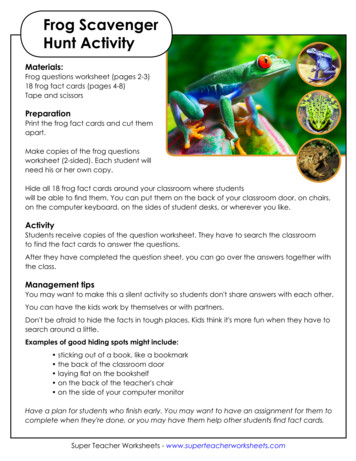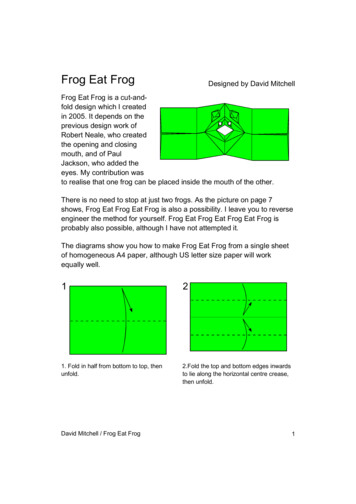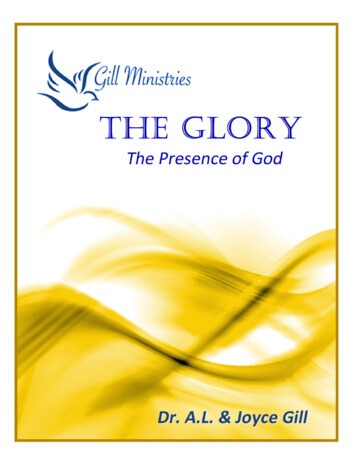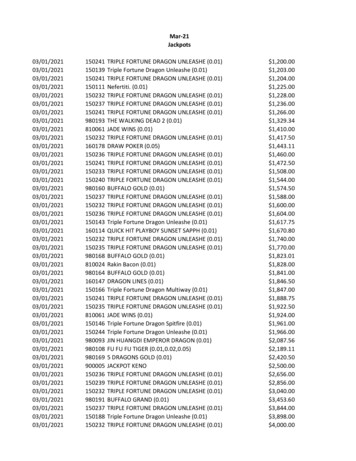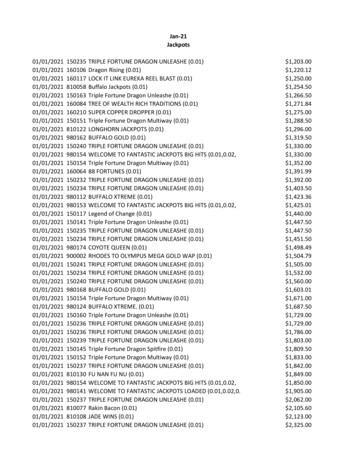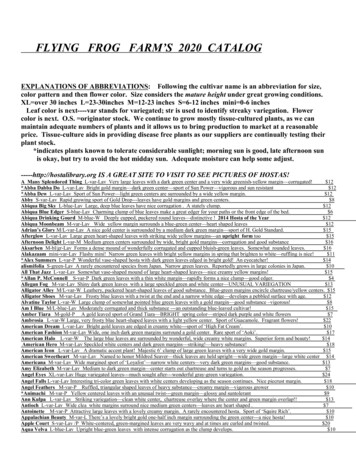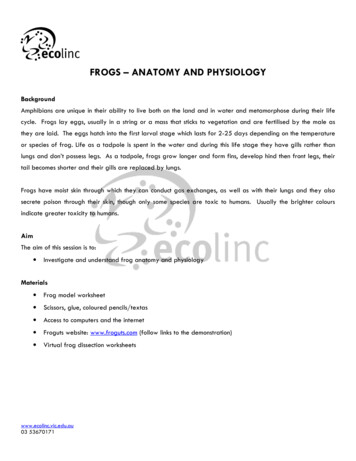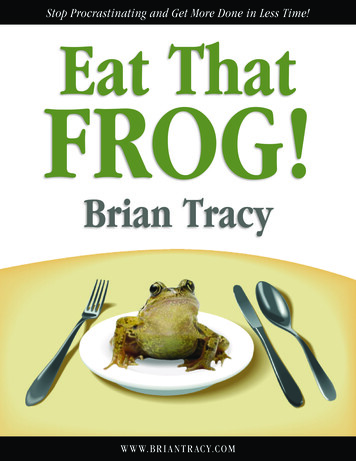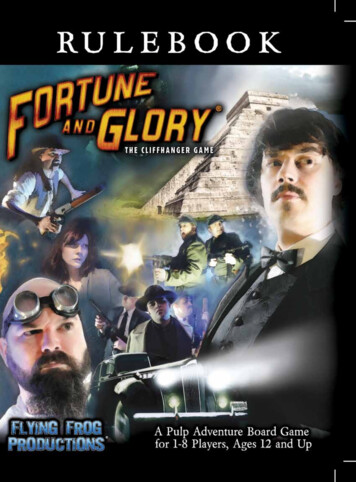
Transcription
Fortune and GloryGame ContentsTHE CLI FFH ANG ER G A M EByJason C. HillIt is the late 1930s and the world is in turmoil. Humanity is onthe brink of war as imperialist nations in the Far East and Europework aggressively to expand their domination. The Nazis havetaken control of Germany and now spread darkness across theglobe in their hunt for powerful occult artifacts that can give themthe upper hand in the days to come. But the spirit of adventureand freedom won’t be stamped out so easily.Heroic adventurers from around the world answer the call,racing against time to hunt down ancient artifacts, explore deadlytemples, and fight back the powers of darkness from engulfing theworld. It is a race of good versus evil and only a cunning andagile explorer can claim the ultimate prize of Fortune and Glory!Game OverviewFortune and Glory , The Cliffhanger Game is a fastpaced game of high adventure, vile Villains, edge-of-yourseat danger, and Cliffhanger pulp Movie Action. Playerstravel the globe in search of ancient artifacts, fending offdanger and Villains at every turn in a quest for ultimatereward. So strap on your adventure boots and goggles, fireup the engines on the seaplane, and grab some extra ammofor your revolver the Nazis already have a head start and inthis race for Fortune and Glory, there’s no prize for secondplace!Gameplay BreakdownEach player takes on the role of a pulp adventureHero, hunting down ancient artifacts around the world andcollecting Gear and Allies to help overcome the variousEnemies, Dangers, and Villains that stand in their way.During each Game Round the Heroes roll off to determinethe First Player then all get to Move (starting with the FirstPlayer), and then all get to Adventure (starting with theFirst Player). There are two resources in the game, Fortuneand Glory. Heroes collect Glory by defeating Enemies andovercoming Dangers and then spend that Glory to Healwounds and buy Gear and Allies. They collect Fortune byrecovering Artifacts and selling them in cities.In the Competitive Game, players race againstone another to be the first to collect 15 Fortune. In theCooperative Game, all of the Heroes work together towarda larger collective Fortune total as they race against a VileOrganization played by the game itself.Pulp Adventure and Historical ContextFortune and Glory is set in the Pulp Adventuregenre of the late 1930s. As such it includes Enemies andVillains that are part of the Nazi party that had taken hold inGermany at the time (as well as the corresponding historicaliconography). The usage of Nazis and their iconographyis purely rooted in historical context and is absolutely notintended to condone or glorify them or their actions in anyway. If you find this material strongly objectionable it is ourrecommendation that you do not use this product. Pleasegame responsibly.2 Players1 Full-Color Rulebook1 Game Board8 Small White Dice8 Small Green Dice30 Gold Plastic Fortune 1-pieces30 Gold Plastic Fortune 5-pieces30 Crystal Blue Plastic Glory 1-pieces30 Crystal Blue Plastic Glory 5-pieces16 Plastic Nazi Soldier Figures8 Plastic Mobster Thug Figures6 Unique Plastic Villain Figures8 Unique Plastic Hero Figures8 Plastic Temple Pieces1 Plastic Zeppelin8 Large Hero Character Sheets2 Large Vile Organization Record Sheets2 Large Tactics/Outpost Charts1 Large Zeppelin Record Sheet20 Card Allies Deck20 Card Gear Deck20 Card Enemies Deck20 Card Nazi Enemies Deck45 Card Event Deck40 Card City Deck25 Card Artifacts Deck25 Card Adventures Deck45 Card Locations Deck40 Card Dangers Deck30 Card Villain Event Deck12 Card Common Items Stack6 Villain Cards8 Summary Cards2 Enemy Reference Cards3 Die-cut Counter Sheets1 CD Soundtrack of Original MusicFortune and Glory , The Cliffhanger Game can beplayed by 1-8 players, either Competitively or Cooperatively.It also offers a Team Game option, as well as a Solo playexperience. Due to the length of game, it is recommendedthat Competitive Games with more than 5 players shoulduse the Team Game option. Also, Cooperative Games ofmore than 4 or 5 players will likely have an extended gamelength.
Competitive and CooperativeFortune and Glory has two main styles of play:the Competitive Game, where each player races againstone another, hunting down ancient artifacts from aroundthe world and sabotaging each other along the way; or theCooperative Game in which all of the players work togetheragainst a Vile Organization bent on world domination (runby the game itself) and requiring a larger group goal to win.The default style of play is Competitive, and thus describedfirst in the rulebook.Game ComponentsDiceThe game comes with 16 standard six-sided dice (8White and 8 Green) that should be divided amongst theplayers. There are two colors of dice included with theintent that the Green dice can be used for attacking Enemiesand the White dice for the Heroes rolls. Often cards willrefer to the terms D6 and D3. D6 is just another name fora six-sided die. D3 means to roll a six-sided die and consultthe following chart:D6 RollResult1–23–45–6123First Player MarkerThe First Player Marker is usedto keep track of which player goesfirst during each phase of thecurrent Game Round. This isdetermined by all of the playersrolling off during the InitiativePhase at the start of each newGame Round.Exploration Markers(Advanced)Some Spaces on the board are consideredDeep Jungle. When a Hero wants to huntdown an Artifact that is located within a DeepJungle, they must first explore to find it. TheseExploration Markers keep track of the Hero’s timespent searching.Instability Markers(Advanced)When a Hero (or Villain) adventures inan ancient Temple to find the treasure within,there is always a chance that the Temple willbegin to crumble and collapse. InstabilityMarkers are used to record how close a Temple is tocollapsing in on itself.Wound MarkersThese red Wound Markers are placedon characters and Enemies to keep track ofhow much damage they have taken duringthe game. There are individual Wound Markersas well as larger pieces representing 5 Wounds each.Artifact TokensThese are colored pairs of skull shapedmarkers that show where each Artifact is locatedon the board. One of the tokens is placed onthe Artifact card and the corresponding tokenis placed on the board in the Space that theArtifact resides.Success and DangerMarkersThese markers are used to keeptrack of how many successes a Hero(or Villain) has gotten so far on agiven Test that they are taking. On theflip side is a Danger Marker that lets a Herokeep track of how many Dangers they have overcome ontheir current Adventure.Auction MarkerOccasionally the Heroes will find that anAuction is going on in a city where they can selltheir Artifacts for a variable bonus. When thishappens, an Auction marker is placed on thatCity Space.The Villain Track and Track Marker(Cooperative Only)This numbered track is used in theCooperative Game to mark how close theVillains are to winning the game. Thecircular donut-shaped marker starts at 0 andmoves up the track as the Villains collectArtifacts and gain power. The Villain Track isnot a turn counter, but rather only moves whenspecifically called on to do so.Outpost Tokens(Cooperative Only)Vile Organizations each havetheir own unique type of Outpostthat they use during the CooperativeGame. These are bases of operationthat are placed on the board andgive the Villains a bonus of some kind.Occupation/Hideout Markers(Cooperative Only)Often times a Vile Organization’s influencewill spread to new areas of the board. Thesemarkers are used to indicate areas that are inthe control of the Villains.3
Additional Counters16 green Nazi Soldiers; 8 green Mobster Thugs; 8 greenTemples; and 1 red Nazi Zeppelin. Also included are 120plastic coins in gold for Fortune and crystal-blue for Glory.These are divided into 1-pieces and 5-pieces.Several additional counters havebeen provided. These are not neededfor the main game but can be used forhouse rules or future official content.Fortune and Glory CD SoundtrackPlaying PiecesFortune and Glory , The Cliffhanger Game comeswith its own CD Soundtrack of original music to listen towhile you play the game. It is not necessary and does notaffect gameplay, but you may find it enhances the experienceby setting the mood and immersing the players in the game.There are 8 unique, grey Herofigures, each matching one of theHero character sheets. There arealso 6 unique, red Villain figures,each matching one of the Villain cards;Miniature Identification GuideDuke DudleyJacques MoreauJake ZaneLi Mei ChenDr. ZhukovSharon HunterCartwrightShelly HargroveTempleFranco Fedicci“Icebox” EddieVanessa LoveFortune 1-PieceMobster ThugNazi SoldierNazi ZeppelinFortune 5-PieceCardsKeywordsMost cards have Keywords associated with them, listedjust below the image. The Keywords do not have anyinherent meaning, but are occasionally referenced by othercards and rules. Some important Keywords have an iconassociated with them that can be found in the upper rightcorner of the text area (such as Gun, Sidekick, or Fire).Card IconsSome cards have Keyword Icons on them to emphasizea certain Keyword (such as Fire or Sidekick). A legend ofthese icons can be found on the back of the rulebook.Shuffle IconWhen a card has the Shuffle Icon, itmeans that after the card is discarded thediscard pile for that deck should be shuffledback in to reform the deck (including the cardthat had the Shuffle Icon).Bonus Fortune IconSome cards have a Bonus Fortune Icon. Ifthis is on an Enemy card (such as Nazi Gold)4Herr TeufelGlory 5-PieceTresaColonel StahlGlory 1-Piecethen the bonus Fortune is taken when the Enemy is defeated.If it appears on a Location card, the bonus Fortune is onlyused when the card is drawn for the placement of an Artifact(as described later).Play ImmediatelySome Event cards are listed as Play Immediately. As itsounds, these cards must be played as soon as they are drawn.Occasionally a player will be allowed to draw multiple cardsand choose one to keep, discarding any others. When thisis the case, a ‘Play Immediately’ card is only played if theplayer chooses to keep that card.Remains in PlaySome cards are listed as Remains in Play. Again, asit sounds, these cards stay in play and continue to affect thegame until they are canceled in some way.Discard PilesFor each deck of cards in the game there will also be adiscard pile. The discard pile should be formed face up nextto the deck and is where cards from that deck go when theyhave been used and are no longer in play. Any player maylook through any discard pile at any time. If any deck everruns out of cards, shuffle the discard pile thoroughly andreform the deck face down.
Card TypesEvent CardsEvent cards are special bonuses thatHeroes get during the game (though somedo have negative effects). Unless marked‘Play Immediately’, Events are taken intoa player’s hand and kept secret. They maybe strategically played to give yourself anadvantage or to slow other Heroes down.Events are played as fast effect style cardsand, unless noted otherwise, may beplayed at any time.City CardsCity cards are drawn by a Herowhenever they visit a City. They are a fairlyeven mix of good and bad, and can lead toanything from getting a free Gear or Ally togetting caught up in a city-themed Danger.Some City cards have a Secret Icon in theupper left corner; these cards are kept secretwhen drawn just as though they were anEvent card.Gear and AlliesGear and Alliesare cards that upgradea Hero by giving thembonuses to their Skills oreven extra abilities. AHero may use all of theGear and Allies that theyhave, but are limited tocarrying no more than 3 Gear and 3 Allies.Enemies and NaziEnemiesThese cards representdifferent Enemies thatHeroes can encounterin their adventures. ADanger will always let youknow which deck to drawyour opponent from.Artifact and Adventure CardsArtifact and Adventure cardsare usually drawn together as theyeach represent half of a dynamicallygenerated Artifact placed out on theboard. These two cards are nestedtogether to form one completeArtifact (for example, ‘The Skull’ ‘ofMedusa’). The Artifact card has aFortune Value which is the worth ofthe Artifact, while the Adventure cardhas a Dangers Value that shows howdifficult it is to recover. The blackand white icons along the right edgeof the cards are Keyword Icons andhave no inherent meaning, but maybe referenced by other cards.LocationsLocation cards are used to drawRandom Spaces on the board. Eachcard has the name of a Space as well asa small map with a red X showing wherethat Space is located on the board. Thereare also a number of terrain icons belowthe map that show what terrain is in thatSpace. Each Location card also has a Citylisted at the bottom for drawing RandomCities.Common ItemsThe Common Items do not need tobe shuffled. Instead they form a face upstack of cards that can be purchased byHeroes while in a City. Common Itemshave a number in the upper right cornerwhich is the cost of Glory needed for aHero to buy that card.Dangers/CliffhangersThesedoublesided cards representtheDangersthatHeroes will need toovercome in their huntfor Artifacts. The frontof each card shows aDanger, while the backshows the Cliffhangersituation that will ariseif the Danger side Tests are failed.Villains (Advanced Only)There are six Villain cards, eachrepresenting one of the unique Villaincharacters in the game. Each Villain hasSkills, Wounds, Defense, and Abilities justlike the Heroes. They also have a factionicon in the upper left corner to showwhich Vile Organization they belong to:the Nazis or The Mob. Villains are anadvanced element of the game and are a large part of theCooperative Game especially.Villain Event Cards(Cooperative Only)Villain Events are only used in theCooperative Game and represent evilbonuses that the Villains get in their questfor power.EnemyReference CardsOccasionally a card will call for aHero to fight a specific Enemy rather thandrawing from a deck. These two doublesided reference cards show four commonEnemies that Heroes might encounterduring a game (Mobsters, Nazi Soldiers,Zombies, and Order of the Crimson Hand).5
Reading CardsThe Game BoardMost cards in the game should be read aloud to allplayers when drawn, starting with the card title. The onlyexceptions to this areEvent cards and someCity cards (ones thathave the Secret Iconin the upper leftcorner).The game board for Fortune and Glory is a late 1930sadventure map of the world. There are 3 types of Spacesthat make up the board – Land Spaces, City Spaces, andSea Spaces. Every Space on the board has the name of thatSpace printed on it. Sea Spaces also have a large numberprinted on them that shows the movement cost to enter thatSea Space.Only Event cards andsome City cards are keptsecret when drawn by aplayer. All other cards shouldbe read aloud when drawn.Heroes & Vile OrganiZationsTerrain IconsMany Spaces have one or more Terrain Icons in them toshow what types of terrain cover that region. These icons donot have any inherent meaning, but, much like Keywords,certain cards and abilities play off of them.JungleMountainsDesertIceSeaHero Character SheetsEach of the eight Heroes is represented by a HeroCharacter Sheet that lists their Skills, unique Abilities, andother information.Land SpacesLand Spaces are the areas of ground on the map andare separated by thick black lines to delineate their borders.Note that some Land Spaces are a small grouping of islandsthat are all connected into a single Space. Where these areadjacent to one or more other Land Spaces, there is a thickblack line looped out around them to show the Space’sborder (such as the British Isles or Japan).Vile Organizations (Cooperative Only)Each Vile Organization has a Record Sheet that showsits special rules, Faction Icon, and Henchmen. There is alsoa double-sided chart with the Vile Organization’s Tactics onone side and unique Outposts on the other.The Zeppelin (Advanced Only)The Zeppelin also has a double-sided Record Sheetwith its special rules listed. One side is The Zeppelin, whichis used as an Advanced Element in the Competitive Game.The other side includes the War Zeppelin, which is part ofthe Nazi Vile Organization for use in the Cooperative Game.6For example, the British Isles is a Land Space that is adjacentto the Western Europe Space. Even though there is a thin strip ofwater that appears to separate the two Spaces, the thick black linelooped out around the islands shows that models can move fromone Land Space to the other without having to go out to Sea.
City SpacesCity Spaces are spread around the board and appear ascircular icons surrounded by a silver or gold colored borderwith the name of the City in it. City Spaces count just likeany other Space on the board for movement. Occasionallya City Space will be fully within another Land Space (suchas the Paris City Space is within the Western Europe LandSpace). In these cases, models must move through the LandSpace to get to or leave the City Space.Major and Minor Cities – There are two types ofCity, Major Cities and Minor Cities. Major Cities are a bitlarger and have a unique depiction of the specific city theyrepresent, surrounded by a gold border. Minor cities aresmaller and have a generalized city image to represent all ofthem, surrounded by a silver border.Major Cities and Minor Cities work more or less thesame in the game, with the main difference being that MajorCities are called out more often by specific cards, and Heroesget a small bonus for selling Artifacts in a Major City ratherthan in a Minor City.Port Cities – Some Cities have a Port City icon onthem, meaning that they are adjacent to not only LandSpaces, but also to one or more Sea Spaces. Models ina Port City may move directly to or from an adjacent SeaSpace without having to go through any Land Spaces. ThisPort City icon is more for clarity of movement than anythingelse, though occasionally a card or ability will reference PortCities.Sea SpacesSea Spaces are the blue water areas of the mapand are separated from each other by thick blacklines. They are also separated from the Land Spacesby lighter-colored, rippling coastline. Every Sea Spacealso has a Sea Icon in it.Pacific Crossing – On each side edge of the map is ahalf circle marked Pacific Crossing. This is actually a singleSpace and is a way for models to move from one edge ofthe map to the other (traveling around the world). Notethat the ONLY Space that is connected from one edge to theother is the Pacific Crossing – the other Pacific Sea Spaces areNOT connected from one edge to the other and are NOTconsidered adjacent.Movement Cost – Each Sea Space has a large numberprinted in it which shows the movement cost to enter thatSpace. All of the other Spaces on the board (Land Spacesand City Spaces) always just cost 1 movement to enter. If amodel does not have movement remaining equal to or morethan the Sea Space’s movement cost, it may not enter thatSea Space.Random Locations and Random CitiesWhenever a Random Location is needed, simply draw aLocation card. Each Location card represents one Space onthe board and has a simple map that shows a red X wherethe Space appears on the game board. Note that at thebottom of each Location card there is also a City listed foroccasions when you need to draw a Random City instead.7
Fortune and GloryThere are two resources in the game, Fortune andGlory. These are marked with the plastic coins provided inboth 1-pieces and larger 5-pieces. The Gold coins should beused to mark Fortune and the Crystal Blue coins should beused to mark Glory.Fortune is the victory resource in the game. OccasionallyFortune is used for other things, but it is primarily collectedup until the Hero has enough to win the game. Gloryon the other hand, is the spending resource. It is gainedby overcoming Dangers and defeating Enemies and can bespent while in a City to buy Gear and Allies cards, as well asto buy Common Items and to Heal wounds.SkillsHeroes have four Skills: Combat, Agility, Cunning,and Lore. These different Skills are used during the game tomake Tests and fight Enemies.Combat (Red) – Combat shows a character’s abilityto fight, whether it is bare-fisted brawling or their skillwith a pistol. It also represents basic strength.Agility (Yellow) – Agility represents how good acharacter is at running, jumping, ducking, sneaking,and general physical prowess.Cunning (Green) – Cunning represents how wellthe character can solve puzzles, spot traps, and thinktheir way out of a bad situation, as well as theirunderstanding of technology and science.Lore (Blue) – Lore shows a character’s knowledgeof other cultures, locales, legends, and history. Thisis often used to read ancient glyphs, fight fantasticalEnemies, and decipher the occult powers of ancientArtifacts.Making Skill TestsOften a Hero is called on to make a Test using one ormore of their Skills. A Test has three parts to it – The type ofSkill needed, the target number for each die rolled to countas a Success, and the total number of Successes needed topass the Test (the smallsymbols).To make a Skill Test, roll a number of dice equal toyour Hero’s Skill of that type. So if it is an Agility Test, youwould roll a number of dice equal to your Hero’s AgilitySkill.These dice are called Adventure Dice. EachAdventure Dice that rolls the required numberfor the Test or higher counts as a Success. Inthe example above it is an Agility 5 Test, soeach die that rolled 5 or 6 would count as aSuccess. Put a Success Marker on the card foreach Success rolled.As long as you roll at least one Success, youmay roll your Adventure Dice again. You maycontinue to roll until you get no Successes.If you have gotten Success Markers equal to or morethan the number of Successes required, the Test is passed. Ifyou do not roll enough Successes, the Test is failed.Additional Adventure Dice may always be added afterthe roll by cards, Abilities, or by increasing your Skill insome way.Combined Skill Tests and Non-Skill TestsSome Tests require the use of two or more Skillscombined, or do not use any Skills at all. These Tests alwayshave extra text to describe how they are passed or failed.ExertingIn some very dangerous moments it is possible for aHero to push themselves to their limits to try and survive.While in a Cliffhanger Test or making an Escape Test (andONLY during a Cliffhanger or while trying to Escape), aHero may Exert, taking Wounds on themselves to roll extraAdventure Dice (note that Cliffhangers and Escape Tests arecovered a bit later).For each Wound that a Hero Exerts, theyare allowed to roll 1 extra Adventure Dice.A Hero may Exert as many times as they like (andmay do so one at a time), but may not KO themselves byExerting. Another important note is that the extra AdventureDice from Exerting is only for the current roll. If the Herogets to roll the dice again (for having gotten at least oneSuccess), the extra Adventure Dice from Exerting are NOTincluded in subsequent rolls.8
Gear and AlliesGear and Allies are cards that a Hero can acquire toincrease their Skills and Abilities. Whenever a Hero getsa Gear or Allies card, simply draw the top card of theappropriate deck and place it face up on the table next to theHero’s Record Sheet.Buying Gear and AlliesWounds and DefenseWoundsIn the lower right corner of a Hero’s Record Sheet thereis a wooden crate with the Hero’s Wounds value. This isthe amount of damage that the Hero can take before theyare knocked out. When a Hero takes one or more Wounds,a number of Wound Markers are placed on their RecordSheet to track how much damage they have taken. If theHero ever has Wound Markers equal to or greater than theirWounds value, they are KO’d.DefenseRight next to a Hero’s Wounds value is a little bar thatshows the Hero’s Defense (this is usually 0 or 1).Defense is the number of Hits that the Heroprevents every time that they take one or moreHits (in a Fight or otherwise).HealingAnytime a Hero gets to Heal one or more Wounds,those Wound Markers are simply removed from the Hero’sRecord Sheet. If a Hero gets to Fully Heal, all WoundMarkers are removed from their Record Sheet.Being KO’dA KO’d Hero is placed back in their Starting City withtheir figure laid down on its side. They do not participate inthe game in any way until they Recover during the next EndPhase. There is also an additional penalty for being KO’d.Any time a Hero is KO’d they mustimmediately roll a die and discard the amountrolled in any mix of Gear cards, Allies cards,Glory, and Fortune.In addition, the Hero must roll a die foreach Artifact they are currently carrying. Onthe roll of 1, 2, or 3, that Artifact must also bediscarded.The Hero may choose what Gear, Allies, Glory, andFortune they lose, but they must lose the full amount rolledif possible. For this reason, it is good to try and keep alittle extra Glory as a buffer in case you are KO’d (as Glorytends to be easier to get than Gear, Allies, or Fortune). It isgenerally a good idea to sell Artifacts as soon as you can onceyou recover them.Gear and Allies cards may be purchased using Glorywhile in a City. When purchased, draw the top card fromthe deck and add it to your Hero.It costs 5 Glory to buy a Gear or Allies card.Carrying LimitA Hero may carry up to 3 Gear and up to 3 Allies ata time (a total of 6 cards) and may use any and all Gear andAllies they are carrying. If a Hero ever has too many Gearor Allies, they must discard down to their limit.ActivateSome Gear and Allies must be Activated to use one ormore of their abilities. This just means that the ability is oneuse per turn. When Activated, flip or rotate the card to showthat it may not be Activated again this turn. While Activated,any other Skill Bonuses or non-Activate abilities on the cardMAY still be used.Loyalty TestsAllies have a special Skill in the lower left corner of theircard called Loyalty. This is used when an Ally is called onto make a Loyalty Test. To make the Test, roll a number ofdice equal to the Ally’s Loyalty Skill. If any of the dice rollthe number needed for the Test, the Test is passed. If not,the Test is failed and the Ally must be discarded (there isoften an additional effect as well, based on whatever causedthe Test).Common ItemsAnother type of card that Heroes can get is CommonItems. These cards are available to purchase in Cities usingGlory. Common Items work just like Gear and Allies withthe exception that they are not a deck but rather a stack ofcards. This means that Heroes do not get them randomlybut instead may pick and choose the specific card that theywould like to purchase (the cost in Glory is shown in theupper right corner of the Common Item card). There isalso no discard pile for the Common Items stack as anytime one would be discarded, it is instead just returned tothe stack.When purchased, Common Items are placed face upnext to a Hero’s Record Sheet and count toward the carryinglimit of either Gear or Allies, depending on the CommonItem (the first Keyword on a Common Item will always beGear or Ally). In the main game, all of the Common Itemsare Gear.9
The Basic GameTo keep things simple for your first game or two (orfor teaching new players that are not very familiar with moreadvanced board games), you should play a Basic Gameversion of Competitive play. Set aside the Zeppelin, Temple,and Villain figures during Game Setup and remove all copiesof the following cards from the game before shuffling thecard decks (these are all cards that feature concepts coveredin the Advanced Elements section of the rules):Artifacts The MineThe CityThe ValleyThe TempleThe CavernsThe TombEvents Lost TempleCity Trouble in TownDangers Agents of EvilEnemies Mob LeaderNazi Enemies Nazi CommanderYou should also ignore any reference to Villains,Temples, Deep Jungles, or Flying between Cities on cards, aswell as any Special Text listed below the card title on any ofthe Adventure cards10Setting UpSet Up Game BoardUnfold the game board and place it in the center of alarge table where everyone can reach it.Shuffle and Place Card DecksSeparate all of the various card decks and fully shuffleeach of them. You do not need to shuffle the CommonItems as they are a face up stack rather than a deck. Place allof the card decks around the board as shown in the diagrambelow.Draw and Place Hero CharactersShuffle up the large Hero Character Sheets. Each playerthen randomly draws one Hero to play. The remainingHero Characters are set aside and will not be used thisgame. Place your Hero Character Sheet in front of youwhere everyone can see it and take the corresponding Herofigure out of the box.Each Hero has a Start City listed in theupper right corner of their Character Sheet.Each player should place their Hero figure inthe proper Start City.Some Heroes also have abilities that let them start thegame with free cards or other bonuses.
The Competitive GameThe default style of play is the Competitive Game whereall of the Heroes are traveling the world hunting downartifacts and racing against one another to be the first tocollect 15 Fortune and be in their Starting City at the end ofa Game Round.The Game RoundPrepare Counters, Dice, and FiguresPlace all of the Fortune coins, Glory coins, WoundMarkers, Counters, and Enemy Figures around the table sothat all players can reach them. Also, distribute the dicebetween the players.Prepare Dangers DeckShuffle up the Dangers deck and place it where allplayers can reach it. Note that because this is a deck ofdouble-sided cards, anytime a player would draw from theDangers deck they should always draw from the bottomor middle and be sure that the Danger side is face up as itenters play.Draw and Place Starting ArtifactsNow it is time to populate the boardwith Artifacts. Draw an Artifact card andan Adventure card and place them together,nested with one another, along the top o
White and 8 Green) that should be divided amongst the players. There are two colors of dice included with the intent that the Green dice can be used for attacking Enemies and the White dice for the Heroes rolls. Often cards will refer to the terms D6 and D3. D6 is just another name for a six-sided die. D3 means to roll a six-sided die and consult
